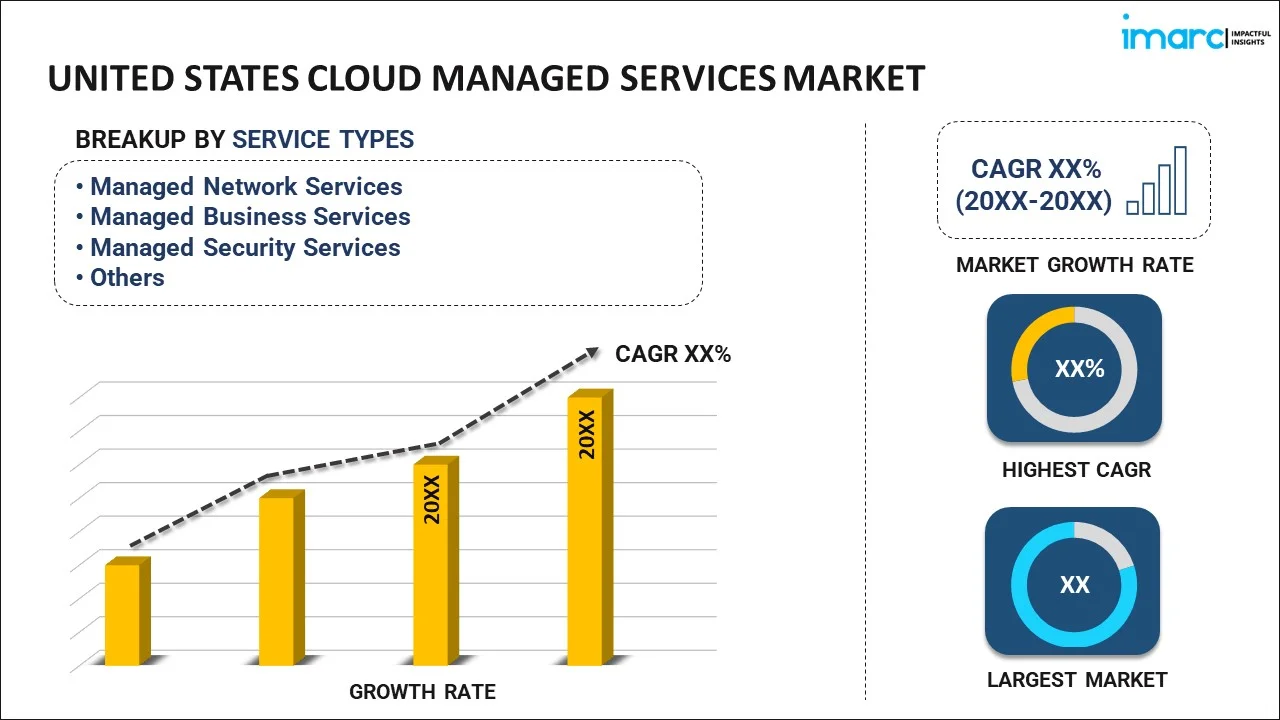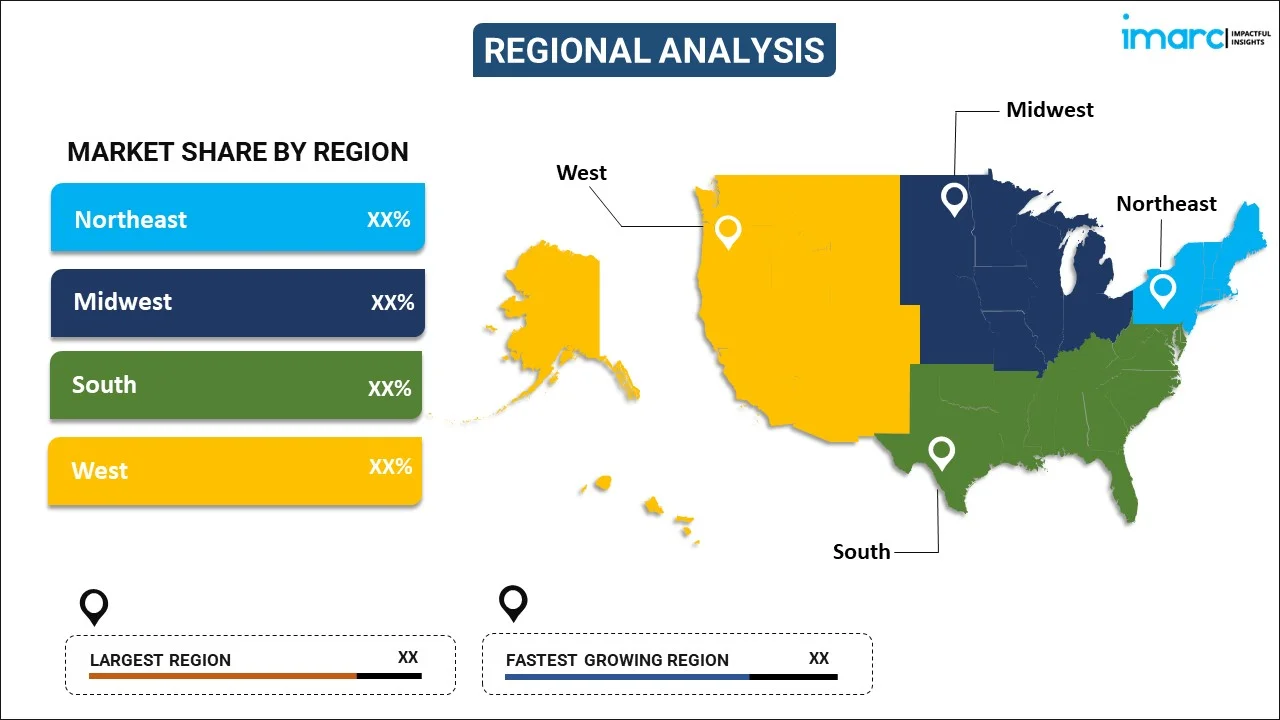
United States Cloud Managed Services Market Report by Service Type (Managed Network Services, Managed Business Services, Managed Security Services, Managed Infrastructure Services, Managed Mobility Services, Managed Communication and Collaboration Services), Deployment Model (Private Cloud, Public Cloud), Organization Size (Large Enterprises, Small and Medium-sized Enterprises), Vertical (Retail and Consumer Goods, BFSI, Telecom, Government and Public Sector, Healthcare and Lifesciences, Manufacturing, Energy and Utilities, IT, and Others), and Region 2025-2033
Market Overview:
United States cloud managed services market size is projected to exhibit a growth rate (CAGR) of 10.55% during 2025-2033. The rising focus among government bodies on security and compliance, along with the growing generation of large volumes of data, is primarily driving the market growth.
|
Report Attribute
|
Key Statistics
|
|---|---|
|
Base Year
|
2024 |
|
Forecast Years
|
2025-2033 |
|
Historical Years
|
2019-2024
|
| Market Growth Rate (2025-2033) | 10.55% |
United States Cloud Managed Services Analysis:
- Major Market Drivers: The increasing adoption of digital transformation initiatives across enterprises, growing cybersecurity concerns, rising demand for cost-effective IT solutions, and government emphasis on secure cloud infrastructure are the primary factors driving United States Cloud Managed Services Market Growth.
- Key Market Trends: United States Cloud Managed Services Market Share is expanding due to hybrid cloud adoption, artificial intelligence integration in service delivery, edge computing deployment, and increased focus on compliance management across various industry verticals.
- Challenges: Organizations face difficulties in vendor selection, data migration complexities, integration challenges with legacy systems, and concerns regarding data security and compliance standards, affecting United States Cloud Managed Services Market Analysis outcomes significantly.
- Opportunities: The growing demand for AI-powered automation, edge computing services, multi-cloud management solutions, and industry-specific compliance requirements present substantial growth opportunities for United States Cloud Managed Services Market demand expansion.
Cloud managed services involve outsourcing a range of IT responsibilities associated with cloud infrastructure and applications to third-party service providers. These services cover diverse tasks like deploying, monitoring, maintaining, securing, backing up data, and recovering from disasters in the cloud. Additionally, they include the management of virtualized components, such as servers, storage, and networking resources. The purpose is to address the technical complexities of cloud management, enabling organizations to concentrate on their primary business goals. These services facilitate the adjustment of cloud resources based on demand, ensuring optimal performance without unnecessary provisioning.
United States Cloud Managed Services Market Trends:
Artificial Intelligence and Machine Learning Integration
The conjunction of machine learning and artificial intelligence technologies is transforming the United States cloud managed services market. The use of AI-based automation is being adopted by service providers to improve predictive analytics, optimize resource utilization, and accelerate incident response times. Machine learning algorithms allow for preemptive monitoring and maintenance, minimizing system downtime and operational expenses. These technologies offer intelligent workload distribution, automated detection of security threats, and dynamic scaling according to usage patterns. Organizations are looking more and more for AI-augmented services that give them real-time insights into their cloud infrastructure performance. The trend is also seen in automated compliance monitoring, where AI systems constantly monitor regulatory compliance and provide compliance reports. This technology helps businesses attain greater operational efficiency at the cost of less manual intervention requirement. Service providers are putting significant investments in AI capabilities to differentiate their offerings and offer value-added services that legacy managed services cannot provide.
Multi-Cloud and Hybrid Cloud Management
The shift towards multi-cloud and hybrid cloud models is fueling strong demand for expert managed services within the United States market. Companies are more and more loading workloads onto multiple clouds to escape vendor lock-in, reduce costs, and increase resilience. This creates an elevated need for advanced management solutions that can easily bridge disparate cloud environments while ensuring uniform security, governance, and performance. Managed service providers are creating all-encompassing platforms that provide end-to-end visibility and control over various cloud infrastructures. The intricacy of handling many clouds makes room for specialized services such as cloud orchestration, inter-platform migration, and integrated monitoring solutions. Organisations appreciate especially those services offering consistent management interfaces independently of the underlying cloud platform. This trend is additionally fueled by compliance requirements that enforce data residency as well as certain compliance standards in various geographies and cloud platforms.
Edge Computing and IoT Management Services
The growth of Internet of Things devices and edge computing use cases is driving new opportunities in the cloud managed services marketplace. Compute resources are being brought closer to data sources by organizations in order to minimize latency and enhance real-time compute capabilities. These developments call for specialized managed services that can support distributed computing environments, edge device management, and in-edge and in-cloud integrated resource seams. Service providers are building capabilities to manage edge infrastructure, roll out security measures for distributed environments, and provide consistent connectivity among edge nodes and core cloud platforms. The automotive, manufacturing, and healthcare sectors are specially boosting the demand for managed services with edge capability. Such services consist of real-time data processing, predictive maintenance of IoT devices, and analytics solutions based on the edge. The growing use of 5G technology further fuels this trend by supporting more advanced edge computing use cases that need professional managed services for peak performance and dependability.
United States Cloud Managed Services Market Segmentation:
IMARC Group provides an analysis of the key trends in each segment of the market, along with forecasts at the country level for 2025-2033. Our report has categorized the market based on service type, deployment model, organization size, and vertical.
Service Type Insights:

To get more information on this market, Request Sample
- Managed Network Services
- Managed Business Services
- Managed Security Services
- Managed Infrastructure Services
- Managed Mobility Services
- Managed Communication and Collaboration Services
The report has provided a detailed breakup and analysis of the market based on the service type. This includes managed network services, managed business services, managed security services, managed infrastructure services, managed mobility services, and managed communication and collaboration services.
Deployment Model Insights:
- Private Cloud
- Public Cloud
A detailed breakup and analysis of the market based on the deployment model have also been provided in the report. This includes private cloud and public cloud.
Organization Size Insights:
- Large Enterprises
- Small and Medium-sized Enterprises
The report has provided a detailed breakup and analysis of the market based on the organization size. This includes large enterprises and small and medium-sized enterprises.
Vertical Insights:
- Retail and Consumer Goods
- BFSI
- Telecom
- Government and Public Sector
- Healthcare and Lifesciences
- Manufacturing
- Energy and Utilities
- IT
- Others
A detailed breakup and analysis of the market based on the vertical have also been provided in the report. This includes retail and consumer goods, BFSI, telecom, government and public sector, healthcare and lifesciences, manufacturing, energy and utilities, IT, and others.
Regional Insights:

- Northeast
- Midwest
- South
- West
The report has also provided a comprehensive analysis of all the major regional markets, which include the Northeast, Midwest, South, and West.
Competitive Landscape:
The market research report has also provided a comprehensive analysis of the competitive landscape. Competitive analysis such as market structure, key player positioning, top winning strategies, competitive dashboard, and company evaluation quadrant has been covered in the report. Also, detailed profiles of all major companies have been provided.
Recent News and Development:
- In January 2025, Google Cloud announced several key updates. Windows Server 2025 is now generally available on Google Compute Engine with pay-as-you-go licensing, including SQL Server 2022 support. Google also introduced Agentspace, combining Gemini AI, enterprise data, and Google-quality search to boost employee productivity. Other highlights include the Check Grounding API’s new helpfulness score, A3 Ultra VMs with NVIDIA H200 GPUs in preview, and expanded tools such as Mandiant’s CTI Playbook, subsea cable connectivity for Tuvalu, and reCAPTCHA Password Leak Detection.
- In November 2024, AWS announced the general availability of Microsoft Remote Desktop Services (RDS) with AWS-provided user-based subscriptions. Customers can now purchase RDS licenses directly from AWS on a per-user, per-month basis, simplifying license management and reducing overhead. This eliminates the need for separate Microsoft agreements while supporting existing Active Directory for user access. With AWS License Manager, customers gain centralized tracking, governance, and cost control—enabling seamless scaling of GUI-based applications on Amazon EC2 without rebuilding instances.
United States Cloud Managed Services Market Report Coverage:
| Report Features | Details |
|---|---|
| Base Year of the Analysis | 2024 |
| Historical Period | 2019-2024 |
| Forecast Period | 2025-2033 |
| Units | Billion USD |
| Scope of the Report | Exploration of Historical Trends and Market Outlook, Industry Catalysts and Challenges, Segment-Wise Historical and Future Market Assessment:
|
| Service Types Covered | Managed Network Services, Managed Business Services, Managed Security Services, Managed Infrastructure Services, Managed Mobility Services, Managed Communication and Collaboration Services |
| Deployment Models Covered | Private Cloud, Public Cloud |
| Organization Sizes Covered | Large Enterprises, Small and Medium-sized Enterprises |
| Verticals Covered | Retail and Consumer Goods, BFSI, Telecom, Government and Public Sector, Healthcare and Lifesciences, Manufacturing, Energy and Utilities, IT, Others |
| Regions Covered | Northeast, Midwest, South, West |
| Customization Scope | 10% Free Customization |
| Post-Sale Analyst Support | 10-12 Weeks |
| Delivery Format | PDF and Excel through Email (We can also provide the editable version of the report in PPT/Word format on special request) |
Key Benefits for Stakeholders:
- IMARC’s industry report offers a comprehensive quantitative analysis of various market segments, historical and current market trends, market forecasts, and dynamics of the United States cloud managed services market from 2019-2033.
- The research report provides the latest information on the market drivers, challenges, and opportunities in the United States cloud managed services market.
- Porter's five forces analysis assist stakeholders in assessing the impact of new entrants, competitive rivalry, supplier power, buyer power, and the threat of substitution. It helps stakeholders to analyze the level of competition within the United States cloud managed services industry and its attractiveness.
- Competitive landscape allows stakeholders to understand their competitive environment and provides an insight into the current positions of key players in the market.
Need more help?
- Speak to our experienced analysts for insights on the current market scenarios.
- Include additional segments and countries to customize the report as per your requirement.
- Gain an unparalleled competitive advantage in your domain by understanding how to utilize the report and positively impacting your operations and revenue.
- For further assistance, please connect with our analysts.
 Request Customization
Request Customization
 Speak to an Analyst
Speak to an Analyst
 Request Brochure
Request Brochure
 Inquire Before Buying
Inquire Before Buying




.webp)




.webp)












